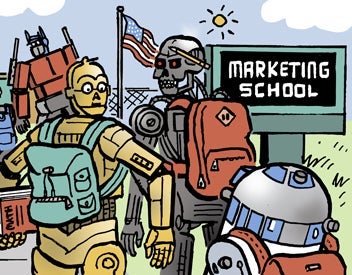Comparison shopping engines can help you boost sales and acquire customers — provided your company’s product is a top contender among the search results. And that doesn’t mean your company has to offer the lowest prices for the merchandise featured.
Unlike a general search engine such as Google, AltaVista, or Yahoo!, where visitors search for relevant information on a vast array of subjects, comparison shopping engines allow shoppers to research the price and details of specific products. If the customer finds an item at a desirable price, the shopping site will redirect him to the merchant’s site to make the purchase. All comparison sites are not created equal, though. Each engine uses its own particular algorithm for ranking and displaying search results. Each also has different criteria and charges for participating merchants.
Of the major engines, only Froogle and Shopzilla offer free listings. In addition to the free listings, though, Froogle — an outgrowth of Google — does charge merchants to participate in its advertising plan, AdWords, in return for preferred placement in a column to the right of the nonpaid results. Similarly Shopzilla provides free product listings, but it also charges merchants to appear at the top of the search results.
The costs to participate in paid-inclusion comparison sites such as MySimon, NexTag, PriceGrabber, and Shopping.com vary depending on product category. Most sites do not charge a set-up or joining fee but instead charge $0.05-$0.10 per lead (cost-per-click, or CPC) in categories with low-margin products such as books and toys, and $1.00 or more per lead in high-margin categories like ink cartridges. Most sites, however, allow merchants to purchase or bid for higher CPC rates to appear in preferred merchant rankings.
From price to sponsorship, comparison shopping sites use a variety of algorithms to sort product search results. Most of the major search engines use product price as a common sorting focus, followed by store rating and reviews, popularity, relevancy, and placement bids.
All the major shopping engines accept data feeds — files with pricing, product, shipping, and other details that the merchants supply to search engines or affiliates. Only some of the engines, however, will crawl your Website — in other words, coming to you to gather information rather than your pushing data to them. Among those that crawl are Shopping.com, Froogle, and Shopzilla.
According to Jupiter Research, 8% of online shoppers used comparison shopping sites during the 2003 holiday season, whereas 64% used general search engines. But while fewer online shoppers use comparison engines than general-purpose engines, comparison engine users are overall “more intense” shoppers, says Jupiter Research retail analyst Patti Freeman Evans.
Indeed, “one thing that’s really cool is that the people looking to comparison shopping sites are looking for exactly what they need,” says Heather Lloyd-Martin, president/CEO of Bellingham, WA-based agency SuccessWorks Search Marketing Solutions. Any shoppers who come to your site via a comparison engine are in effect prequalified and should have higher conversion rates than other visitors.
As a result, says Alan Rimm-Kaufman, founder of Charlottesville, VA-based Rimm-Kaufman Group, an online marketing consultancy, the cost to acquire customers via comparison engines can be as little as half the cost of acquiring buyers via traditional list rentals. And with shopping engines, catalogers can start out with only a smattering of product listings to see how many new leads they will generate before investing more money.
According to Sarah Leary, vice president of product at Brisbane, CA-based Shopping.com, a comparison shopping engine is “an ROI-positive investment the day you spend [the money], and that is unheard-of marketing. That’s what performance marketing is all about.” Shopping.com charges merchants $0.05-$1.00 per lead and has a conversion-to-sale rate ranging from 2% to 10%.
Most comparison shopping sites will supply merchants with detailed analysis on the number of sales leads in a day in various product categories and customer feedback about how their products are selling. In comparison, Leary says, a company can spend millions of dollars on advertising campaigns in traditional formats such as television without any record of how many people actually viewed the advertisements.
Getting started
One of the beauties of comparison search engines is their testability. Rimm-Kaufman advises testing the various comparison shopping sites as well as the products that work best on those sites before making a commitment. Some sites specialize in particular product categories; what’s more, not all the sites attract the same type of shopper.
“You should be able to dip a toe in the water without long-term onerous costs or time constraints,” says Rimm-Kaufman, who encourages catalogers to dig into the reports issued by the comparison sites to see what’s really going on. High-ticket items may not be selling well, for instance, but lower-ticket items with add-ons and upsells can easily make up for the difference. Rimm-Kaufman’s best advice: Evaluate the data often, and don’t be afraid to “slice and dice” the information to take out underperforming products.
Make a point of visiting the shopping sites yourself, suggests Lloyd-Martin, paying attention to the categories you click on, and looking at listings in categories you’re interested in entering. From those findings, you’ll know what you need when you’re ready to start working with the shopping engine to maximize the reach of your listings.
Lloyd-Martin also recommends talking with other companies who use comparison shopping engines to gain a better understanding of how to streamline submitting data feeds and pictures and how to analyze ROI. “Get a hint of what you’re up against and dealing with,” she says.
As to whether to go with free listings with comparison shopping sites like Froogle or paid sites like PriceGrabber.com, “everyone digs the free stuff,” notes Lloyd-Martin. Although free listings may not generate as many purchases as paid listings, the added revenue is money that cost you virtually nothing to earn.
Lloyd-Martin doesn’t recommend using only free listings, however, because they may not provide a significant lift in sales. Instead, she advocates supplementing free listings with paid listings on other sites such as Shopping.com and Yahoo! Shopping.
And even if you don’t offer the lowest price on a comparison engine, most experts recommend getting in on the game. About 70% of click-throughs on comparison sites are not on the merchant with the lowest price, says Jupiter’s Evans. More online shoppers are seeking a quality experience. “Yes, people care about price, but it’s not necessarily all about price,” she says. “It’s about the customer getting the best deal and getting the best product at the right price from the right retailer at the right time.”
And before you take the plunge, be sure that your Website is ready to handle the increased traffic that will be sent its way, says Rimm-Kaufman. If your site has a poor transaction mechanism, think carefully before hooking up with a comparison shopping engine. These customers are ready to buy, so your site must be ready to handle the transaction quickly.
Making it work
Just because your company is listed on a comparison site doesn’t mean shoppers will click the link to your site. “Realize that on that search results page you have little opportunity to make an impact,” Lloyd-Martin says.
Which means you need to make the most of what opportunity you have. Most experts agree that consumer interest increases with each additional bit of information you can provide them. So to encourage shoppers to click on your link as opposed to the link above or below yours, try including a logo with your listing and citing the total costs including shipping and tax; you might also add consumer reviews.
On your own site, it’s crucial to pack each product page with your company’s basic information. Visitors directed to your site from a comparison shopping engine will be bypassing your home page and parachuting directly onto the product page.
“Product pages need to be mini home pages,” says Rimm-Kaufman. “You not only need to make the case of why they should buy a widget, but why they should buy a widget from you.”
Kent, WA-based outdoor-gear merchant Recreational Equipment Inc. (REI) struggles with how best to greet customers arriving directly on a product page. “That puts a burden upon us to tell our story on that product page and put our value proposition on that page,” says REI spokesperson Mike Foley.
To make a strong impression on its product pages, REI includes detailed information about the product, how to use it, and its benefits. The pages also feature links to REI’s contact and guarantee information and to the FAQs page. While he won’t share details, Foley says that comparison shopping engines have indeed helped increase sales and traffic to the REI Website.
Once you’re up and running on a comparison shopping engine you need to constantly review the information you’re providing the shopping site and the information it’s providing you.
Relegating the data feed for products to your IT department is a “huge mistake” according to Rimm-Kaufman, because feeds are marketing documents in that the choice of words, offers, and structures is vital to success.
Retail Brand Alliance, which owns apparel merchants Brooks Brothers and Casual Corner, has been working with direct response marketing firm SendTec to improve its data feeds. On Shopping.com recently, for instance, only five Brooks Brothers listings appeared in the men’s clothing category, says Angie McCloskey, vice president of business development for St. Petersburg, FL-based SendTec. In the same category, outdoor products marketer Bass Pro Shop had 6,252 products listed.
“What that’s telling you is that products are not pulled correctly through data feeds,” McCloskey says. But by fine-tuning the feeds with better-written copy and an understanding of how the comparison engine categorizes products, she adds, you can increase a company’s visibility on a comparison site.
For Kristen Pollock, search and affiliate manager for Brooks Brothers and Casual Corner, improving the brands’ visibility on Froogle and Shopping.com is a priority. “We have extensive product catalogs for Brooks Brothers and Casual Corner, and obviously these are places we want to be,” she says.
| PriceGrabber www.pricegrabber.com |
Shopping.com www.shopping.com |
Froogle www.froogle.google.com |
NexTag www.nextag.com |
Shopzilla (formerly BizRate) www.shopzilla.com |
Yahoo! Shopping www.shopping.yahoo.com |
MySimon www.mysimon.com |
|
|---|---|---|---|---|---|---|---|
| Size of audience | 15-16 million/month (Dec. est.) | 3 million/day | Not available | Over 10 million/month | 13.2 million/month | Not available | Not available |
| No. of participating merchants | 5,000 | 28,000 | Not available | More than 3,000 | 50,000 | Not available | 1,500 |
| Cost to participate | $0.25-$1.00 per click | $0.05-$1.00 per click | Free (costs vary for AdWords) | Starts at $0.09 per click* | $50 setup fee; $0.10-$1.00 per click | $0.15-$1.00 per click | $0.15-$1.00 per click |
| Ranking methodology | Price | Store rating, price | Relevancy | Cost-per-click rate | Featured store, “smart choice”*, price | Product description, popularity, user ratings | Sponsorship, relevancy |
| Preferred listings available? | Yes, 40% higher premium | Yes, for top three CPC bids | Yes, Google AdWords program | Yes | Yes, for highest bidder | Yes | Yes, “preferred” and “premier” |
| How to submit product info | Data feed | Data feed, crawl ($20 charge) | Crawl, data feed | Data feed | Data feed, crawl | Data feed | Data feed |
| ROI info provided? | Yes | Yes | Not available | Yes | Yes | Yes | Yes |
| *Rankings based on price paid per click | *Best price, store rankings, instock, shipping charges |
 Network
Network

